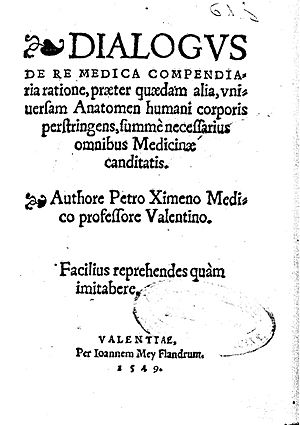Pedro Jimeno facts for kids
Pedro Jimeno (born around 1515 – died around 1555) was an important Valencian scientist. He was known for studying the human body, a field called anatomy.
Contents
Early Life and Studies
Pedro Jimeno was born around 1515. He might have been born in Valencia or in Onda. He started his education at the University of Valencia, where he studied general subjects.
Later, he went to the University of Padua to study medicine. There, he learned from a very famous doctor named Andreas Vesalius. Vesalius was known for his new ways of teaching anatomy.
Teaching Career
After finishing his studies, Jimeno returned to Valencia. In 1547, he became a professor of anatomy at the University of Valencia. This meant he taught students all about the human body.
In 1549, he also started teaching practical medicine. This involved teaching students how to treat sick people. In 1550, Jimeno moved to the University of Alcalá. He continued teaching there until he passed away a short time later.
Important Discoveries
Pedro Jimeno was one of the best students of Andreas Vesalius. He strongly believed in Vesalius's new ideas about anatomy. Jimeno helped bring these modern teachings to Spain.
He worked with another doctor, Francisco Vallés, in Alcalá. Jimeno wrote only one book. It was called Dialogus de re medica. This book was published in Valencia in 1549. It was written like a conversation between a citizen and a doctor. This book was the first complete work on Vesalian anatomy published in Spain.
The Stapes Bone
Jimeno's book, Dialogus, contains a very special discovery. It has the first published description of the stapes. The stapes is the smallest bone in the human body. It is found in the ear.
Jimeno found this tiny bone by carefully studying human bodies. He likely discovered it in 1547 or 1548. Another scientist, Giovanni Filippo Ingrassia, had found it earlier in 1546. However, Jimeno's book was the first to describe it in print. Ingrassia's own discovery was not published until much later.
Legacy
After Pedro Jimeno's death, his work was continued by another scholar, Luis Collado. Collado kept teaching Jimeno's ideas, even though some people disagreed with them. Jimeno's contributions helped change how anatomy was taught and understood in Spain.
See also
 In Spanish: Pedro Jimeno para niños
In Spanish: Pedro Jimeno para niños


